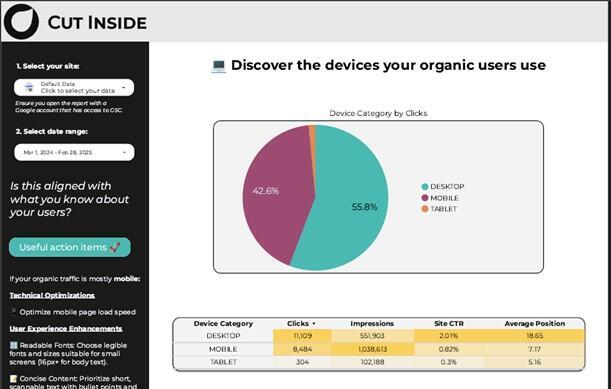In cooperation with Cut Inside
As AI-driven tools reshape how people search for information online, many businesses are discovering that outdated SEO strategies no longer deliver results. Without clear visibility in organic search, even strong brands risk falling behind — while competitors gain trust, traffic, and long-term positioning
In today’s digital-first environment, visibility in search engines is not a luxury — it is a basic requirement for staying relevant.
Still, many businesses operate without realizing the blind spots in their SEO efforts, and as a result, miss out on significant opportunities to grow through organic channels.
The belief that paid advertising or social media alone can support long-term growth often leads to disappointing results.
Search engine optimization is not only about increasing traffic — it is about attracting users who are actively looking for specific solutions. Businesses that fail to invest in organic search are not simply staying in place — they are giving their competitors a clear advantage.
Recent trends show that companies focusing on effective SEO strategies based on user intent are achieving better visibility and higher rankings, not only in traditional search engines but also in AI-driven tools like generative search platforms and large language models.
It’s not how many; it’s who finds you
Many business owners and marketing professionals still associate SEO with a general effort to increase traffic. But the true value of SEO lies in its ability to attract users who are already in the process of searching for specific products or services. This level of relevance makes organic search one of the most effective ways to engage high-intent audiences.
Overlooking SEO can result in more than just missed clicks: When a brand is absent from relevant search results, potential customers may never encounter its offering. That absence often means losing ground in shaping the public conversation, weakening the brand’s position as a trusted authority in its field.
In the absence of consistent organic visibility, businesses often become dependent on paid channels. But paid traffic vanishes the moment the campaign ends. In contrast, a solid presence in search results can deliver ongoing visibility and long-term stability.
Search performance is also closely tied to credibility. Users tend to place more trust in sites that appear prominently in search rankings. When competitors occupy those positions, they are more likely to influence decision-making and set the tone in the market.
3 View gallery


A website’s mobile experience plays a central role in its search visibility.
(Photo: shutterstock)
A growing number of companies are discovering that by analyzing their search data and optimizing their content accordingly, they can increase the relevance of their site and generate stronger, more qualified leads. This strategic approach to SEO not only enhances visibility but also supports more efficient marketing investments
What structured SEO analysis can tell you about your current visibility
One of the first steps in understanding how your site performs in search is reviewing where your traffic comes from. Geographic data, for instance, often reveals surprising patterns. Businesses sometimes discover that a significant portion of their organic traffic originates from countries they have not actively targeted, raising questions about whether multilingual content or regional optimization is needed.
Another key element in SEO analysis is device usage. With mobile-first indexing now standard, a website’s mobile experience plays a central role in its search visibility. If most of your visitors arrive via mobile but encounter slow load times or confusing navigation, your rankings — and your conversion rates — may be suffering as a result.
Different types of content contribute differently to organic success. Pages such as blog posts, product descriptions, or landing pages may vary widely in performance. A good SEO report helps identify which pages bring in the most traffic and whether they are also effective in leading users to take action. Underperforming content can often be improved by better aligning it with what users are actually searching for.
In some cases, a site may rely heavily on just a few high-performing pages to generate the bulk of its traffic. While this can be an asset, it also poses a risk. If rankings change, traffic can drop sharply. By identifying and expanding on topics that already show strong performance, websites can build a more balanced and resilient presence in search results
Why second-page rankings may hold the key to faster growth
Many websites have content that ranks just below the first page of search results — often in positions eight to twenty. While these pages may not attract significant traffic at the moment, they represent clear opportunities for improvement. A few targeted adjustments can often help push them into the top results where visibility increases sharply.
One way to identify these opportunities is by looking at keywords that have high search impressions but low click-through rates. These cases often suggest a mismatch between what users are expecting to see and how the page is presented. Refining the meta title, rewriting the description to better match intent, or improving internal links can all make a meaningful difference.
Another common situation is a page that almost meets the user’s needs but falls short in clarity or relevance. Adjusting the content to reflect actual search behavior — such as adding clear explanations, structured information, or answering common questions — often leads to better performance in both rankings and user engagement.
These quick adjustments do not require overhauling a site’s entire SEO strategy. They rely on using existing data to identify low-hanging opportunities that can deliver measurable results in a relatively short time.
Turning insights into action is what sets visible brands apart
Many businesses already have access to the information they need in order to improve their SEO performance. The challenge is not a lack of data, but rather the absence of a clear process to interpret it and translate it into meaningful steps.
A structured analysis of search performance can help identify blind spots in a company’s strategy, highlight areas where targeted improvements can make a real impact, and support smarter prioritization of content and technical fixes.
By focusing on user intent, improving key pages, and responding to actual search behavior, businesses can enhance both their visibility and the value they deliver to potential customers. In an increasingly competitive digital environment, the ability to be found organically is not just an advantage — it is a foundation for long-term relevance.
Search is happening with or without you. The question is whether your brand is part of the conversation.
In light of these trends, Tel Aviv–based agency Cut Inside has developed an interactive report designed to help website owners better understand the structure of their organic traffic — independently and securely.
This article was written In cooperation with Cut Inside



